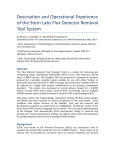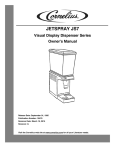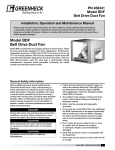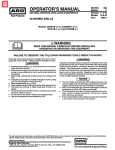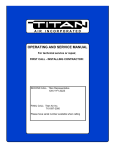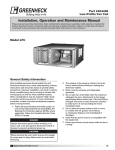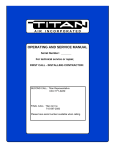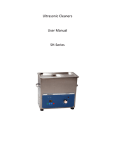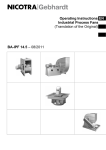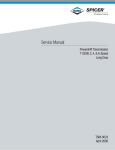Download Marley Engineered Products 770IC Operating instructions
Transcript
MARLEY ENGINEERED PRODUCTS OPERATING INSTRUCTIONS AND PARTS LIST TUBE AXIAL DUCT FANS INDUSTRIAL PROPELLER FANS INDUSTRIAL ROOF EXHAUSTERS HEAVY DUTY MAN/PRODUCT COOLERS WARNING BY ACCEPTANCE OF THIS MERCHANDISE, THE PURCHASER AND USER ASSUME COMPLETE RESPONSIBILITY UNLESS UNIT IS OPERATED IN COMPLIANCE WITH ALL FEDERAL AND LOCAL LAWS AND REGULATIONS. ROTATING EQUIPMENT MUST BE PROPERLY GUARDED TO PREVENT PERSONAL INJURY Receiving and Start-up Instructions General Maintenance V-Belt Drives Bearing Maintenance Ordering Replacement Parts Trouble Shooting CONTENTS Page 2,3 Page 4 Page 4,5 Page 6,7 Page 8 Page 9 RECEIVING & START-UP Receiving Inspection When unit is received, inspect immediately for damaged or missing parts. Even though all units are carefully inspected and prepared for shipment at the factory, rough handling enroute may cause concealed damage or cause nuts, bolts or locking collars to work loose. Check propeller to see that it rotates freely and that there are no obstructions. Be certain all bolts and locking collars are tightened securely. If concealed damage is found, call the carrier and ask for their Inspection Department. Then fill out a concealed damage inspection report. Handling: Handle your equipment with care. Some fans are provided with lifting lugs or holes for easy handling. Others must be handled using nylon straps or well-padded chains and cables, which protect the fan's coating and housing. Spreader bars should be used when lifting large parts. DO NOT LIFT AXIAL FANS BY THE MOTOR, MOTOR BASE OR PROPELLER. Axial fans should be lifted by using straps around the fan housing. DO NOT LIFT ROOF VENTILATORS BY THE STACK CAP OR HOOD. Roof ventilators should be lifted by using straps around the fan housing or base only. Spreader bars should also be used to avoid damage to stack caps or hoods. Installation: Fans should always be mounted to a flat, level and rigid structure. Shim the fan where necessary. This will ensure permanent alignment and a smooth running, vibration free fan, as well as minimize maintenance costs. Poured concrete foundations are recommended, wherever practical, for floor mounted fans. Fans mounted off ground level should be rigidly mounted to a structural platform and be placed as near as possible to or over, a solid wall or column. Supports for suspended fans must be crossbraced for live load support to prevent side sway. OPERATION Before Start-Up 1. Inspect all fasteners to make sure they are secure. A. Foundation bolts B. Set screws in fan wheel and V-Belt drive C. Housing, bearing and motor mounting bolts 2. Access Doors should be tight and sealed. 3. Bearings should be checked for alignment and lubrication. 4. Turn rotating assembly by hand to insure that it does not strike housing. If the wheel strikes the housing, the wheel may have sustained damage, moved on the shaft, or the bearings may have shifted in transit. Correction must be made before start up. 5. Check motor to insure proper speed and electrical characteristics. A. When making electrical connections ensure that a qualified electrician adheres strictly to the wiring diagram on the motor nameplate or in the motor terminal box. Special attention should be given to being sure that a single phase motor is connected only to a single phase supply of proper voltage, and that a three phase motor will only operate on a three phase supply. Electric motors will burn out and fail immediately if improperly connected. It is also recommended that in every motor connection an overload device be installed between the current supply and the motor to protect the motor from under voltage conditions and motor overloads. 6. Check V-belt drive for alignment. Start-Up 1. "Jog" the motor to check proper wheel rotation. The motor should be started in accordance with the manufacturer's recommendations. Arrows on fan indicate the proper direction of rotation and airflow. 2. Fan may now be brought up to speed. Watch for anything unusual such as vibration, overloading of bearings and motors, etc. 3. Check motor amperage against nameplate amperage to ensure motor is not overloading. GENERAL MAINTENANCE CAUTION: Before any maintenance or service is performed, be sure that unit is disconnected from power source to prevent accidental starting. Periodic inspection of all the fan parts is the key to good maintenance and trouble free fan operation. Frequency of inspection must be determined by the user and is dependent upon the severity of the application. NEVER SERVICE OR ADJUST ROTATING EQUIPMENT WHILE IT IS OPERATION. LOCK OUT THE POWER SOURCE BEFORE PERFORMING MAINTENANCE. Regular fan maintenance should include the following: CAST ALUMINUM & METAL PARTS A. Cast aluminum and steel parts usually do not require maintenance during the life of the unit except painted metal surfaces that require periodic repainting. In a severe, dirty operation, the propeller should be cleaned with a wire brush to prevent an accumulation of foreign matter that could result in fan unbalance. After cleaning propeller, inspect for possible cracks or excessive wear, which can cause unbalance. DO NOT operate a propeller that is cracked, chipped, broken blades or excessive wear. NOTE: If propeller set screws are loosened and/or propeller is removed from shaft, set screws must be replaced. Set screws cannot be used more than once. MOTOR MAINTENANCE B. 1. Removing dust and dirt: Blowout open type motor windings with low pressure air to remove dust or dirt. Air pressure above 50 P.S.1. should not be used as high pressure may damage insulation allowing excessive temperatures. 2. Lubrication: Under normal conditions, ball bearing motors will operate for five years without re-Iubrication. Under continuous operation at higher temperatures (exceeding 104°F. ambient) or dusty atmosphere, re-Iubricate after one year. Bearings are located in the end shields of the motor. Repack each bearing and fill cavity in back of bearings 1/3 full with Alvaniz Grease NO.2 (Shell Oil Company) or equivalent. Motors with non-regreasable, sealed-bearings require no lubrication for the life of the bearing. V-BELT DRIVES C. Care should be taken not to over tighten V-belt drive. Excessive belt tension overloads fan and motor bearings. It is much less expensive to replace belts worn from slippage than to replace bearings damaged from excessive loading. Fan shipped completely assembled have had V-belt drive aligned at the factory. Alignment should be re-checked before operation as a precaution due to handling during shipment. 1. Be sure sheaves are locked in position. 2. Key should be seated firmly in keyway. 3. Place straight edge or taut cord across faces of driving and driven sheaves to check alignment. The motor and fan shafts must be parallel with V-belts and at right angles to the shafts. 4. Start the fan. Check for proper rotation. Run fan at full speed. A slight bow should appear on slack side of belt. Disconnect power and adjust belt tension by adjusting motor on its sliding base. All belts must have some slack on one side. 5. If belts squeal at start up, they may be too loose. 6. When belts have had time to seat in the sheave grooves, then re-adjust belt tension. V-Belt driven assembly can be mounted as follows: 1. Clean motor and fan shafts. Be sure they are free from corrosive material. Clean bore of sheaves and coat with heavy oil for ease of shaft entry. Remove oil, grease, rust or burrs from sheave grooves. 2. Place fan sheave on fan shaft and motor sheave on its shaft. DO NOT POUND SHEAVES ON as this may damage bearings. 3. Move motor by adjusting base so belts can be placed in grooves of both sheaves without forcing. Do not roll belts or use a tool to force belts over the grooves. 4. Align fan and motor shafts so they are parallel. The belts should be at right angles to the shafts. A straight edge or taut cord placed across the face of the sheaves will aid in alignment. 5. Tighten belts by adjusting motor base. Correct tension gives the best drive efficiency. Excessive tension causes undue bearing pressure and can lead to premature bearing failure. 6. Start the fan and run it at full speed. Adjust belt tension until only a slight bow appears on the slack side of the belts. If slippage occurs, a squeal will be heard at start-up. Eliminate this squeal by tightening up the belts. 7. Give belts a few days running time to become seated in sheave grooves, then re-adjust belt tension. If the shaft becomes scratched or marked, carefully remove sharp edges and high spots such as burrs with fine emery cloth or honing stone. Avoid getting emery dust in the bearings. Do not apply any belt dressing unless it is recommended by the drive manufacturer. V-belts are designed for frictional contact between the grooves and sides of the belts. Dressing will reduce this friction. Belt tension on an adjustable pitch drive is obtained by adjusting the motor base, not by changing the pitch diameter of the adjustable sheave. BEARING MAINTENANCE D. SEALED BEARINGS: Sealed for life bearings are pre-lubricated with the correct amount of manufacturer-approved ball bearing grease, and are designed for application where relubrication is not required. Units feature two single row deep groove bearings in rugged cast aluminum or cast iron bearing bracket. Dirt and grease guard seals are an integral part of the assembly. For high temperature applications, the bearings are pre-lubricated with high temperature greases. RELUBRICATABLE BEARINGS Selection of the correct bearing grease and greasing intervals depends on several items. Extreme high or low temperatures, dirty or damp surroundings, are all items that will require more frequent greasing or special greases. Conditions Around Bearing Operating Temperature of Fan Moderate to Extremely Dirty up to 160°F 160°-200°F plus* Fairly Clean Cold Storage Room up to 120°F 120°-160°F 160°-200°F plus* Greasing Intervals 6-12 months 2-3 months 1-2 months 1-2 months 2-4 weeks every defrosting period or no more than 4 months * For fan applications over 200°F: greasing intervals should be from several days to 2 weeks, depending on the temperature. ** For vertical installations, greasing intervals should be twice as frequent as table values For most applications, a lithium base grease conforming to a NLGI grade 2 consistency should be used. This type of grease inhibits rust, is water resistant, and has a temperature range of -30°F to 200°F with intermittent highs of 250°F. When greasing bearings it is important not to overgrease. This is especially true if the bearings are equipped with extended grease lines and the bearings are not visible. In this case more bearing failures occur due to overgreasing than undergreasing. The motor bearings and fan bearings on belt drive fans should be greased at regular intervals. Motor manufacturers greasing instructions and recommendations should be followed closely. Avoid the use of a pressure greasing system, which tends to fill the bearing chamber completely. NOTE: On motors with non-regreasable, sealed-bearings, no lubrication is required for the life of the bearing. RECOMMENDED GREASE: Temperature -30°F to 200°F: Chevron SRI #2, Shell Alvania EP #2, Standard Oil Factran EP #2 Temperature 200°F to 375°F: Shell-Aeroshell NOS 16 & 22, Endura Polymer #802, Dow Corning DC44 (not compatible with non-silicon based grease). AIR FLOW E. Make sure there are no obstructions to airflow in outlet or inlet ductwork. HARDWARE F. Check tightness of all bolts and set screws. ORDERING REPLACEMENT PARTS The following information should accompany part orders: 1. Motor horsepower, frame size, and motor speed. If motor is to be replaced, furnish voltage, phase, cycle, and enclosure and model number from motor nameplate. 2. Fan speed (if V-belt driven) 3. Serial numbers, model numbers and complete description of the part. SAFETY ACCESSORIES WARNING The responsibility for providing safety accessories for equipment supplied by Americraft is that of the installer and user of this equipment. MARLEY ENGINEERED PRODUCTS sells its equipment with and without safety accessories, and accordingly, it can supply such safety accessories upon receipt of order. The user, in making its determination as to the appropriate safety accessories to be installed and any warning notices, should consider: 1. The location of the installation 2. The accessibility of employees and other persons to this equipment 3. Any adjacent equipment 4. Applicable building codes 5. Requirement of the State Bureau of Safety & Health and Federal Occupational Safety and Health Act.








